SS Physicians
Doctors played an essential role in the operation of the Nazi camp system, and this was particularly the case in the Auschwitz complex. The treatment of patients was not the primary purpose of SS doctors. Most of them did not even touch the filthy and physically broken prisoners; inmate doctors tried to care for them as best they could under the most adverse conditions. SS doctors had the responsibility of maintaining the camp's "ecology".
Click here to read more about the Holocaust in Hungary.
Transports arriving from every corner of Europe were received at the Auschwitz-Birkenau ramp by doctors in SS uniforms who selected the
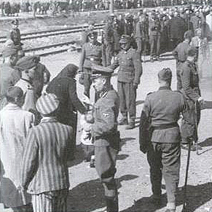 |
SS-Lieutenant Dr. Heinz Thilo selecting Hungarian Jews on the ramp |
Before the arrival of large transports, SS doctors first made selections in the infirmaries and, if this proved to be insufficient, they eliminated the weakest inmates in the barracks. However, the doctors contributed to the mechanism of annihilation not only by making selections, but they also supervised mass executions during the gassings. They gave orders to SS medical non-commissioned officers to introduce Zyklon B gas, they made declarations of death and gave permission to open the gas chamber doors.
Pseudo-scientific experiments
In the camps SS doctors not only became indirectly involved in the process of mass murder, but
 |
In the Auschwitz complex many experiments were in some way related to Nazi racial theory on human biology. Dr Johann Paul Kremer, looking for fresh organs and histological samples needed for his cytological and genetic studies, found the necessary human material in Auschwitz.[2] Dr Horst Schumann studied the quick and cost-effective sterilization of undesirable human groups. He subjected his young patients to X-ray radiation and following the procedure, he removed the testicles of men and the ovaries of women for further testing. Patients who suffered severe burns either died as a consequence of the inhuman treatment or were sent to the gas chambers as unfit for work.
Block 10 in Auschwitz was ruled by the gynaecologist Dr Carl Clauberg, who also experimented with sterilization techniques and the artificial inducement of infertility. On average, 300 to 400 Jewish women between the ages of 20 and 40 lived in this block in constant fear. They received better provisions than other inmates did, but they paid a heavy price. Clauberg pumped various caustic agents into their wombs or ovaries, naturally without anaesthesia despite the unbearable pain. As a result of the operation, women often suffered from peritonitis or ovaritis. On many occasions, following the "treatment", their wombs and ovaries were removed. Often, Clauberg sent women who became severely ill due to his experiments back to Birkenau; they were immediately taken to the crematorium as unfit for work. Many found out only years later that their infertility had been caused by substances referred to by SS doctors as "vitamin injections".[3]
Mengele and the Hungarian Jews
Of all the SS doctors, Dr Josef Mengele became the most notorious. The DEGOB protocols clearly demonstrate
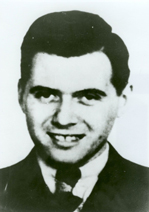 |
Dr. Josef Mengele |
Dr Auschwitz
At his own request, Mengele was sent to Auschwitz on May 30, 1943. As he had the most military awards in the entire garrison in Auschwitz, he commanded the general respect of the SS troops. In 1943 he became the chief doctor of the Gypsy camp (BIIe); from the fall of 1944, one of the chief doctors of the hospital sector for men (BIIf); and chief medical officer (Oberarzt) of sectors BIIa, b and d. At the turn of 1944/45, he became the chief doctor of the SS garrison hospital. Two months after his arrival in Auschwitz he received a grant for his researches form a Berlin institution.[6]
The destruction of Hungarian Jewry was the largest extermination action in the history of the Auschwitz-Birkenau complex and the entire history of mankind. The operation started on May 16, 1944 under the code name Operation Höss, and in the following eight weeks close to half a million Hungarian Jews arrived at the so-called Jewish Ramp in Birkenau. Many who descended from wagons exhausted by days of travel noticed the elegant SS doctor. Studying the DEGOB protocols, the number of references to Mengele's motivations and personal features return in the testimonies of survivors unknown to each other with such frequency that they must be accepted as trustworthy.
1.Through selection the SS doctors responsible for the ecology of the camp simultaneously kept the
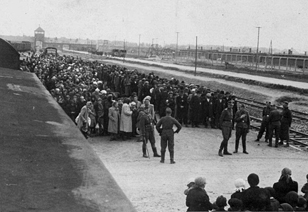 |
Selection of Hungarian Jews. Dr Mengele is smoking on the right side of the picture |
When it came to separating families, the doctor was often aggressive. P. R., arriving from Ungvár in late May 1944, managed to stay with her mother and younger sister at the start of the selection process, but "Dr. Mengele stood there as we arrived in front of him and wanted to separate our mother from us with a cane. When she did not comply, he hit her on the head, but eventually she managed to come with us to the bath."[9] The majority was not so lucky.
2. In a returning theme, deportees and able-bodied inmates sent to the labour camps saw in the
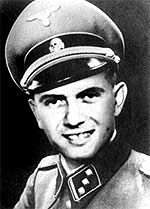 |
"The Angel of Death" |
3. According to many survivor testimonies, in the summer of 1944, as he sent tens of thousands of Hungarian Jews to their deaths, Mengele was wont to whistle classical opera tunes and popular songs. Eighteen-year-old K. H. came from a small village in Carpatho-Ruthenia called Eötvösfalva. In 1944 she was deported to Birkenau and sent to one of the camp's BII sectors as a labourer. Here she learned that "those sent to the left at the station were incinerated", and she also knew that if there was a shortage of victims "they were collected from the different camps of Auschwitz". She remembered selections at the camp: "We had to line up completely undressed and then Dr Mengele came with his assistants and, humming the Blue Danube waltz, he determined whether one lived or died with the wave of a hand."[13] Four young women between 16 and 20 deported from Beregszász spent three weeks in a camp sector in Birkenau when the first selection took place: "This happened as follows: Dr Mengele sent some to their death humming the Blue Danube waltz."[14] Thirteen-year-old G. M. from Nagyszöllős, weakened by diarrhoea, hid from the selection when in "came Dr Mengele whistling the Blue Danube tune and determined our fate by pointing with his finger to the right or left."[15]
4. Based on the DEGOB protocols, it is evident that Mengele represented an extreme form of a
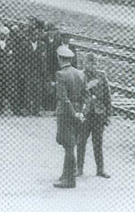 |
Mengele on the ramp |
The testimony of P. R. from Ungvár already quoted above well illustrates the cure/kill paradox so characteristic of Mengele's "doubled" personality: "His double life was incomprehensible. He treated patients with the utmost care, then he sent to the gas perhaps the very same person he cured with his professional expertise. ... A little girl was born in the camp. After delivery he asked the mother how she would name the child. When she said ‘Erika', he said that would not do as that was a German name. He suggested ‘Ilonka', and ‘Ilonka' she became. Two days later he sent the mother and the child to the gas." P. R. knew of several cases where Mengele's "doctor's self" gained the upper hand over his murderous "Auschwitz self". In one case, a patient ordered to wait for Mengele in bed was laughing and dictating song lyrics to a friend when Mengele suddenly appeared from behind their backs. Instead of punishing the girls, he read the text, praised their excellent German and asked where they had learnt it, and "the next day he brought me a piece of chocolate ..., because my German was so good." Another patient suffered from lack of salt. Mengele ordered a medicinal treatment but, probably due to shortages, the patient did not get any help. When Mengele "the next time came to examine the patient and saw that her conditions failed to improve and it turned out that the woman did not receive the prescribed medication, Mengele slapped the attending doctor for her negligence."[17]
However, these incidents represented the exception. Many more remembered a Mengele whose behaviour allowed witnesses to experience his two sides; the sum of these impressions is a kindly murderer who clearly enjoyed his work. According to P. R. quoted above, Mengele loved Jewish children born in sector BIId, "he played with them, took care of them, and then he sent them to the gas".[18] Two girls from Huszt (B. H. and R. C.) aged 16-17 had similar experiences: "In the children's block, selection took place as follows: Dr. Mengerle (sic) talked to the children in the most caring tone, telling them ‘children, if you have the smallest complaint, if anything hurts just tell me and we'll take you to the hospital and you will get better'. He did indeed take them, but these children never returned."[19] The Angel of Death was kind not only to children. Often he turned to young Jewish women as well with extreme courtesy-in the middle of a selection. At the age of 24, F. M. from Ungvár was taken to Birkenau's camp sector (BIIc) reserved for women. Soon Mengele arrived and asked the women if anyone had any medical complaints. "He talked to the girls with such kindness and affection that everyone was touched, for by then no one had talked to them in a human voice for months. We only received blows and were insulted in the foulest language. Dr Mengele told us not be afraid of him, and from now on things will be much better for everyone. If someone then came out and told him her problems, he led her away and she never returned to the barrack."[20] In the various concentration camps it was common practice for guards to come up with special forms of torture for Jewish holidays. Mengele was aware of and enjoyed the custom referred to cynically as "Goebbels calendar": he also liked to make selections on Jewish high holidays. As recalled by the 13-year-old R. L. quoted above, all three selections performed in the Gypsy camp took place "during Jewish high holidays. The first at News Year's, the second on Yom Kippur and the third at Chanuka."[21]
5. For Jews sent to the camps the name of Mengele soon acquired a mystical quality. On the day of her arrival to Birkenau, K. R. from Huszt
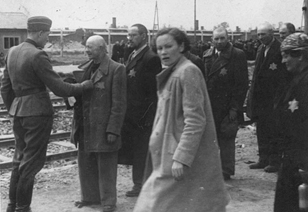 |
Selection |
6. Many survivors often had no clue as to the criteria applied by the doctor in deciding whom to send to the gas chambers. Many recalled that during selection, instead of looking at one's ability to work, Mengele often acted on a whim. It appeared that Mengele took pleasure in making inmates realize over and over
 |
Mengele |
S. K., a seamstress from Munkács, spent weeks in sector BIIc before she managed to get on a transport. "In September and October selections were a daily occurrence. Dr Mengele came in. He had to decide the fate of one thousand people that day, he entered a block, did the zehlappel [Zählappell, i.e., roll call], the person whose face displeased him was sent immediately to the gas. Where siblings or mothers and daughters stood next to each other he separated them - this was one of his passions, to cause as much suffering as possible. If he saw a woman with strikingly beautiful features, he immediately sent her to be gassed. A pimple or the slightest blemish was enough reason for selection. Women undressed to the skin marched before him in the sauna and he waved his hand right and left with delight. When women pleaded with him not to be separated from a sibling or a mother, with a sarcastic smile he reassured them they would see each other in the evening when the other would return."[29]
7. Hungarian survivors mention in over 30 DEGOB protocols that Mengele was on the constant lookout for inmates with any skin blemishes. However, his interest that struck many as peculiar had a
According to a 20-year-old survivor, Mengele sentenced to death all inmates with scabies.[30] "If someone had the smallest pimple or scab, the person was inescapably sent to the crematorium. These unfortunates were then loaded on a truck naked and were driven straight to the crematorium", as K. H put it.[31] In a joint testimony five young Jewish women stated that the selections were extremely thorough, "people with peeling skin or some pimples were sent to the gas."[32]
Mengele selected a girl and her sister from Munkács for a work transport leaving the camp, but in the quarantine block they faced new dangers: "My poor sister scratched herself terribly because of the myriad bed bugs. We were ready to leave when the doctor returned and we had to undress again. He announced that he needed only clean and healthy women and then he held back from the transport my sister and another young girl who had two pimples. This is how my sister remained in Auschwitz and I left with the transport. I tried to leave the column but the doctor yelled at me, there are no sisters here, ‘you are healthy and she is sick', and that is how I had to leave with the transport."[33]
Mengele's experiments
Mengele became the most notorious Nazi doctor with his pseudo-scientific experiments. In the summer of 1943
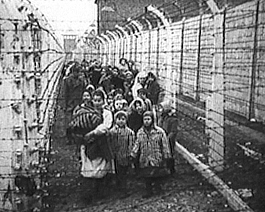 |
"Mengele-twins" after the liberation |
However, his interest soon took a different direction: twins. He started his experiments with Gypsy children and continued with Jewish inmates. Many Hungarian survivors of the Holocaust remember the slightly built, elegant and handsome SS officer who, throughout the summer of 1944, stood on the ramp calling out: "Zwillinge heraus!" ("Twins, step out!"). In all, he collected several hundred twins, young children and old people alike. The majority of them were Hungarian Jews. Mengele arranged accommodation for the twins in various parts of the camp complex (barracks BIIe 29 and 31, barracks BIa 22 and 1 and barrack BIIf 15) where inmate doctors under his command examined everyone and took exact measurements of body parts. Mengele saved the twins (and, in many cases, their mothers) from instant death in the gas chambers; they received better treatment than the rest of the inmates. The doctor was usually kind to them, and occasionally even brought them sweets. However, this apparently agreeable relationship was only a camouflage to hide a gruesome reality. Mengele, studying the secrets of twin births probably with the purpose of increasing German population growth, did not shrink from any methods in his research. If one of the twins died, he shot the other to examine in the autopsy if the sibling suffered from the same disease. He killed Gypsy and Jewish twins with an injection of chloroform to the heart; he attached the veins of brothers, creating artificial Siamese twins, and destroyed many others by unknown means and for unknown reasons. During regular examinations, children stood in the cold naked for hours and large amounts of blood were taken from them. Mengele was also interested in eye-colour abnormalities (heterochromia - the phenomenon of different eye colour). At times, trying to change his patients' eye-colour, he injected blue dye into their eyes, only causing temporary or permanent blindness.
Survivors testifying for the DEGOB protocols also reported on Mengele's experiments. Several witnesses mention that Mengele took blood samples from inmates. E. R. from Gánya and her suspecting companions escaped from the doctors who were drawing inmates' blood.[34] Twenty-year-old L. F. from Alsóapsa remembered as follows: "During the time I was assigned to the kitchen, Mengele came twice to take my blood. Of course I was terrified, I thought I would be taken to the crematorium. Since I had a night job in the kitchen, I always saw the huge fire from the direction of the crematorium."[35] Erzsébet Schönfeld, also from Munkács, also knew of a number of experiments: "The twins were put in a separate group; they took their blood and subjected them to various experiments. I knew a woman disposed to obesity; she was fattened by force and then studied."[36]
The 22-year-old K-Sz. M., a medical intern from Budapest, was sent to the hospital sector BIIf to
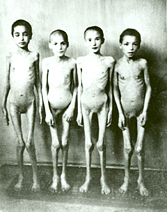 |
Roma children, victims of Mengele's experiments |
Mengele's pathologist: Dr. Miklós Nyiszli
Dr Miklós Nyiszli, a Hungarian Jewish doctor from Nagyvárad, was Dr Görög's supervisor in Birkenau and also one of
 |
Miklós Nyiszli |
In the next few weeks Nyiszli became Sonderkommando doctor at Birkenau. In this position he had free access to the crematoria and had the chance to make detailed observations of the annihilation process. One night Mengele summoned him to a modern autopsy room equipped for him in the crematorium building: "In the workroom next to the autopsy room there were 14 Gypsy twins under SS guard, sobbing bitterly. Without saying a word, Dr Mengele prepared a 10-ccm and a 5-ccm syringe. From a box he took out evipan, from another he placed chloroform in 20-ccm vials on a table. Then the first twin was brought in, a young girl of around 14. Dr Mengele ordered me to undress her and place her on the autopsy table. Then he administered an intravenous injection of evipan in the right arm. After the child lost consciousness, he felt for the left heart ventricle and injected 10 ccm of chloroform. The child was dead after a single convulsion and Dr Mengele had her taken to the morgue. The murder of all 14 twins happened in the same way that night. Dr Mengele asked us if we can perform 7-8 autopsies. To this we replied that to do precise scientific work, we can dissect an average four corpses a day. He accepted that."[42] In his book Nyiszli mentions a number of twin autopsies, among them the case mentioned in K-Sz. M.'s DEGOB testimony, when on the day following the liquidation of the Gypsy camp (probably on August 3) he had to dissect the corpses of gassed Gypsy twin pairs.[43]
Nyiszli survived the October 7, 1944 uprising of the Birkenau Sonderkommando, when inmates blew up
 |
Hypodermic needle used at the pseudo-medical experiments |
With the written permission of his patron, Nyiszli found his wife and daughter in sector BIIc. He provided them with food and clothing, then he arranged for them to be put on a transport to a labour camp, and eventually to Bergen-Belsen, where they were liberated. Thanks to Mengele, Nyiszli and his team survived the last selections of the Sonderkommando, and during the January 1945 evacuation of the camp he managed to join unnoticed inmates of a foot march. After a stopover in Plaszów he ended up in Mauthausen, followed by the concentration camps at Melk and Ebensee. He was liberated there by the Americans. His colleague from Szombathely, Dénes Görög, crumbled under the ordeal: in February in Mauthausen he suffered a nervous breakdown; his subsequent fate is unknown and he is likely to have perished there.[45]
An assessment of Mengele's career
The Mengele "legend" has been woven with many strands. Unlike his colleagues, he did not stuff his pockets with stolen gold, and he did not turn to alcohol to block out reality. Other, often
Mengele was the right man at the right place and the right time. For him, Birkenau was a never returning opportunity, and the twins meant relaxation after a long day's work. He was the happiest when he would discuss with his pathologist, the Hungarian-born Miklós Nyiszli, some of the more interesting cases. If some event failed to meet his expectations, in a second the soft-spoken, dispassionate doctor turned into a raging SS officer reaching for his gun-a clear sign of a split personality.
Some of the inmates used as guinea pigs, several Jewish twins among them, lived to see the liberation of the camp. In January 1945 Mengele left the camp with the "results" of his research. According to the evidence in several DEGOB protocols, in February 1945 he was still seen selecting transports evacuated from Auschwitz in the Parschnitz camp.[46] After the war he hid in Germany for years and then fled to Argentina. On February 7, 1979, he suffered a heart attack while swimming in the ocean at Embu, Brazil. By the time he was pulled to the shore, he could not be saved. The Angel of Death or Dr Auschwitz, as others called him, never faced justice.
Footnotes
[1] See more on this subject in Lifton 1998, pp. 149-153.
[2] On the sins of Dr Kremer see his own diary. Tagebuch des SS-Arztes Johann Paul kremer. In Hefte von Auschwitz 13. Verleag Staatliches Auschwitz-Museum, 1971, Oswiecim.
[3] See more on Schumann and Clauberg in Lifton, 1998, pp. 266-280. On the Auschwitz SS healthcare structure, see Aleksander Lasik: Organizational Structure of Auschwitz Concentration Camp. Department V: SS Medical Service. In Dlugoborski-Piper 2000, pp. I/243-258.
[4] Dr Bruno Kitt (1906-1946) the chief medical officer of the Birkenau women's hospital (Chefarzt des Frauenhäftlingskrankenbaus im KZ Auschwitz II). In the trial of the Neuengamme concentration camp he was sentenced to death and executed by the British authorities. About him see also Protocol 1682. SS-Obersturmführer (lieutenant major) Dr Heinz Thilo (1911-1945 or 1947) selected transports arriving in Birkenau between 1942 and 1944. About him see also Protocols 16, and 894 where his name is given alternately as Till and Tylo. As second defendant in the Bergen-Belsen trial, Dr Fritz Klein (1888-1945) was sentenced to death and hanged by the British authorities. See also Protocols 2257, and 2265.
[5] On Mengele's earlier years see, for instance, Posner-Ware 2000, pp. 4-18 and Lifton, 1998, pp. 332-334.
[6] On Mengele's actions in the various sectors, see Irena Strzelecka-Piotr Setkiewicz: The Construction, Expansion and Development of the Camp and its Branches. Birkenau Sectors BII and BIII as the Men's, Family and Transit Camps. In Dlugoborski-Piper 2000, p. I/90-99.
[7] Protocol 1087.
[8] Protocol 1615.
[9] Protocol 922.
[10] Protocol 254.
[11] Protocol 1448.
[12] Protocol 2448.
[13] Protocol 228.
[14] Protocol 109.
[15] Protocol 1726.
[16] About the "Faustian compromise" of doubling, see Lifton 1998, pp. 413-420.
[17] Protocol 922.
[18] Protocol 922.
[19] Protocol 2281.
[20] Protocol 1142.
[21] Protocol 3327.
[22] Protocol 1484.
[23] Protocol 1302.
[24] Protocol 1310.
[25] Protocol 3327.
[26] Protocol 228.
[27] Protocol 1091.
[28] Protocols 1001.,2824. and 2825.
[29] Protocol 2902. See analysis account of major events in Birkenau in the fall of 1944 in Kádár-Vági 2004, pp. 225-233.
[30] Protocol 1001.
[31] Protocol 228.
[32] Protocol 1485.
[33] Protocol 2532.
[34] Protocol 2812.
[35] Protocol 1001.
[36] Protocol 137.
[37] Protocol 308.
[38] See a comparative study of contradictions and discrepancies found in Nyiszli's DEGOB testimony and his book in Kádár-Vági 1999, pp. 92-109.
[39] Erich Muhsfeldt (or Mussfeld) (1913-1947). Former assistant baker, SS-Oberscharführer (sergeant). From 1940 served in the Auschwitz concentration camp as block commander (Blockführer), then supervised the operation of the Sonderkommando cremating corpses at the Lublin-Majdanek camp, still later he became the commander of the crematorium. In June 1944 he was transferred back to Birkenau, where he served as commander of the two largest crematoria, I and II. After the war an American court sentenced him to death for other crimes, and then handed him over to Poland. In the Auschwitz trial in Krakow he was sentenced again and executed.
[40]Protocol 3632.
[41] On the relationship between Mengele and Verschuer see Lifton 1998, pp. 333-335, 351, and 356, as well as Kádár-Vági 1999, pp. 98-99.
[42] Protocol 3632.
[43] Kádár-Vági 1999, p. 99, and Nyiszli 1994, pp. 41-46, pp. 95-99.
[44] Protocol 3632.
[45] Nyiszli 1994, pp. 157-158.
[46] Protocols 1076, 1448.
References
Dlugoborski - Piper 2000
Waclaw Dlugoborski-Franciszek Piper (eds): Auschwitz 1940-1945 I-V. Central Issues in the History of the Camp. Oswiecim, 2000, Auschwitz-Birkenau State Museum.
Kádár - Vági 1999
Kádár Gábor - Vági Zoltán: Magyarok Auschwitzban. (Hungarians in Auschwitz) In Holocaust Füzetek 12. Budapest, 1999, Magyar Auschwitz Alapítvány-Holocaust Dokumentációs Központ, pp 92-123.
Kádár - Vági 2004
Gábor Kádár-Zoltán Vági: Self-financing Genocide. The Gold Train, the Becher Case and the Wealth of Hungarian Jews. Budapest-New York, 2004, Central European University Press.
Lifton 1998
Robert Jay Lifton: Náci orvosok. Az orvosi eszközökkel történő emberölés és fajirtás lélektana. (Nazi Doctors: Medical Killing and the Psychology of Genocide.) Pécs, 1998, Alexandra.
Nyiszli 1994<
Dr. Nyiszli Miklós: Mengele boncolóorvosa voltam. (I was Dr Mengele's Pathologist in Auschwitz.) Budapest, 1994, Magyar Lajos Alapítvány.
Posner-Ware 2000
Gerald L. Posner-John Ware: Mengele. The Complete Story. New York, 2000, Cooper Square Press.

